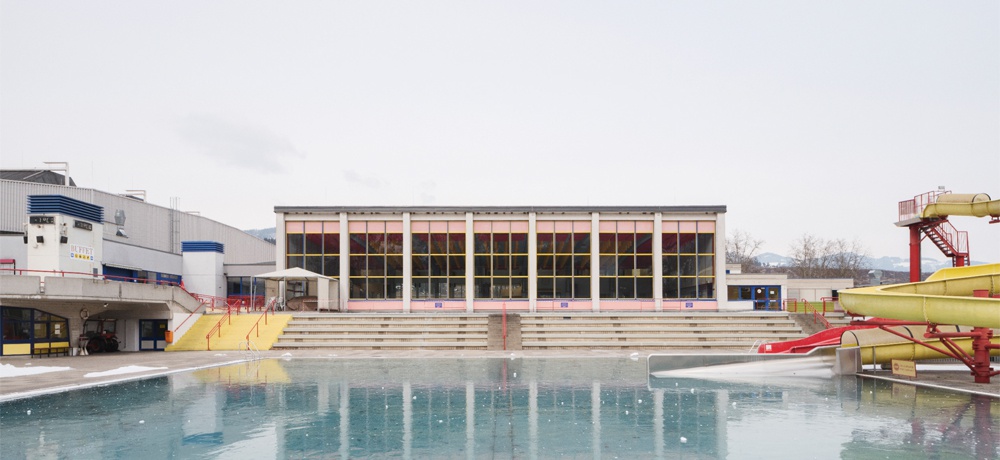Deutsch
Press conference: June 26th, 11 a.m. at HDA (please register by June 20th at: presse@hda-graz.at)
Exhibition opening and book presentation – online: 1st July 2020, 7 p.m.
Exhibition dates: 2nd July – 14th August 2020
Venue: HDA – Haus der Architektur | House of Architecture, Mariahilferstraße 2, 8020 Graz, Austria
Opening hours: Tue-Sun, 10 a.m. to 6 p.m.
Free entry
Guided exhibition tours: Every Saturday at 3 p.m. and Sunday at 11 a.m. you can join a free guided tour. No registration needed.
The architect Ferdinand Schuster (1920–1972) is one of the most important figures of post-war Austrian building culture. He realised churches, industrial buildings, leisure and educational facilities as well as housing, primarily in Kapfenberg and Graz. Schuster’s work developed within the context of his reflections on the cultural, social and political dimensions of construction. He passed on this approach during his teaching activities at Graz University of Technology, where he held the chair for architecture and design from 1964 to 1972. 12th September 2020 would have been Ferdinand Schuster’s 100th birthday. The exhibition and publication mark this occasion by providing an insight into his comprehensive oeuvre.
In the years 1950 to 1972, Ferdinand Schuster was involved in 140 construction and planning projects, shaping post-war architecture in Austria. As an architect, his aim was always to be an advocate of the people and to achieve improvements in their living environment. He made careful use of the resources of material, land, and space as he believed that architecture should prioritise a responsibility towards the building assignment, function, and user over a purely formal gesture.
At the beginning of the 1950s, financial resources were limited—not only in rapidly growing Kapfenberg, but also in other municipalities in Styria. At the same time, however, there was a huge demand for housing as well as new buildings for schools, nursery schools, and workplaces. Ferdinand Schuster was a pioneer of the post-war period, a complex time when many projects had to be accomplished with few resources.
As an employee at the planning department of the Böhlerwerke factory in Kapfenberg, Schuster initially designed numerous residential buildings, a core area that he would continue to focus on throughout his architectural career. In his own architectural practice, he realised educational facilities characterised by versatile spaces and the addition of outdoor areas. Schuster designed schools to feel like a second home, creating an environment that encouraged a trusting relationship between teachers and pupils. These buildings also provided a venue for associations and cultural activities, as well as a focal point for social life in towns and housing developments.
His churches and chapels continue to resonate with visitors today due to their clear, functional spaces where the play of light and religious rituals come together to create a sensory experience. Schuster looked to the typology of the multi-purpose space for the answer to post-war Austria’s increasingly divided society. He had come to the conclusion that “...the division of labour had, without doubt, led to the loss of many “holistic” that were of great importance to humanity...”. He therefore used multi-purpose concepts and residential planning to establish spaces where people would come together on an everyday basis, despite the new urban divisions between housing, work, and leisure propagated at the time.
The traces of Ferdinand Schuster’s architectural work can still be seen today, particularly in Kapfenberg: the existing urban structure is based on the idea of the linear city, which he developed in his dissertation; schools and children’s centres can be extended and are still in use today. In its structural form and construction, the architecture of Ferdinand Schuster is influenced by its period of origin. He used common building materials such as wood, bricks, or cement, applying them with a precise understanding of surface, detail, and impact. Even today, his buildings can still be easily adapted to current developments, in terms of technology, function, society, and atmosphere.
The exhibition and book publication trace the life and works of Ferdinand Schuster, paying tribute to his diverse oeuvre and investigating the relevance of his ways of thinking and approaches for today. After the opening at the HDA in Graz, the exhibition will also be shown in Kapfenberg and Vienna. The comprehensive publication “Ferdinand Schuster (1920–1972). Das architektonische Werk: Bauten, Schriften, Analysen” (An Architectonic Oeuvre: Buildings, Writings, Analyses) is based on several years of research in the framework of an OeNB-project at the Institute of Architectural Theory, Art History and Cultural Studies at Graz University of Technology. It is published by Park Books.
This exhibition is a cooperation between the Institute of Architectural Theory, Art History and Cultural Studies at Graz University of Technology, City of Kapfenberg, Province of Styria and the HDA – Haus der Architektur, Graz.
Supported by Federal Ministry for Arts, Culture, the Civil Service and Sport, Office of the Provincial Government of Styria, Urban Planning Directorate Graz, Ferdinand Schuster Foundation, City of Kapfenberg
Curation and exhibition design: Claudia Gerhäusser, studio cake
Photography and videos: Michael Goldgruber, Vienna
Graphic design: Julia Hendrysiak
PUBLICATION
Ferdinand Schuster (1920–1972)
Das architektonische Werk
Bauten. Schriften. Analysen
Edited by Daniel Gethmann
Park Books 2020
The book is available at the HDA and from bookstores.
SYMPOSIUM
“Ferdinand Schuster. Symposium zum 100. Geburtstag”
(Symposium marking the occasion of Ferdinand Schuster’s 100th birthday)
17th & 18th September 2020
Assembly hall at Graz University of Technology, Rechbauerstrasse 12, 8010 Graz
Organised by the Institute of Architectural Theory, Art History and Cultural Studies at Graz University of Technology
EXHIBITION IN KAPFENBERG
Evangelical Church Kapfenberg, Martin-Luther-Platz 1, 8605 Kapfenberg
Exhibition opening & ceremony: 17th September, 6.30 p.m.
Exhibition dates: 18th September to 8th November 2020
EXHIBITION IN VIENNA
Federal Ministry for Arts, Culture, the Civil Service and Sport, Concordiaplatz 2, 1010 Vienna
Exhibition opening: 12th November, 7 p.m.
Exhibition dates: 13th to 27th November 2020


